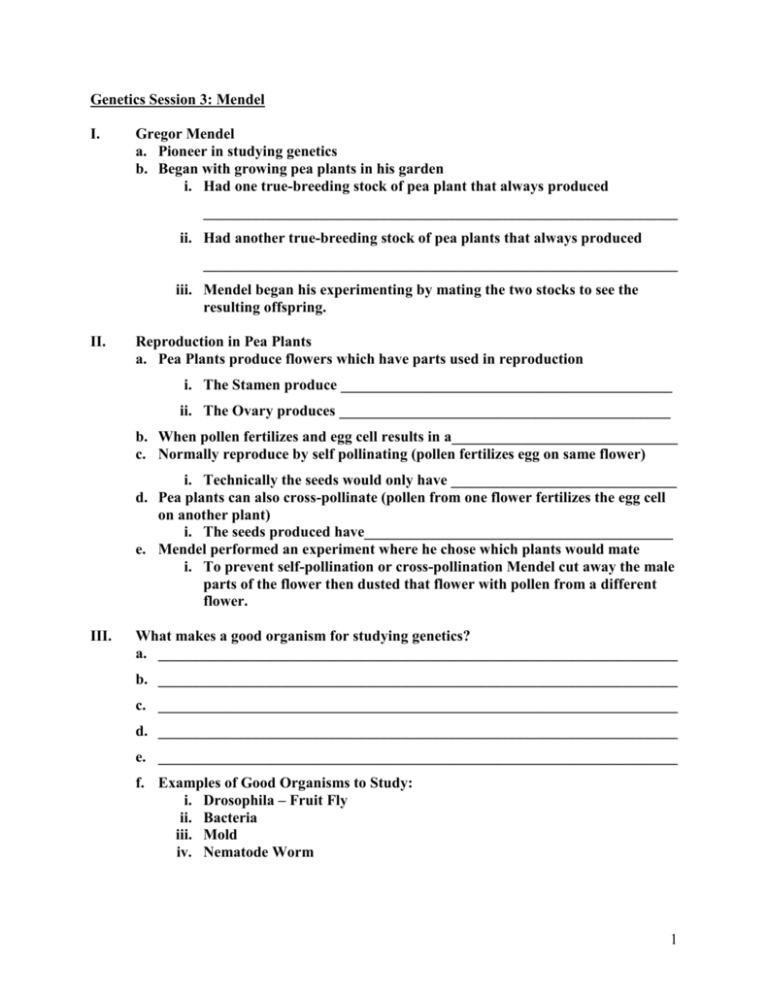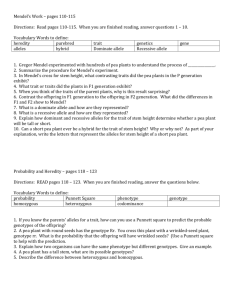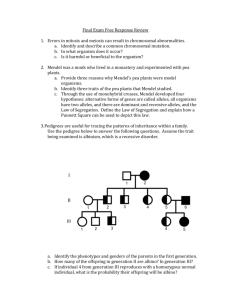Genetics Session 3: Mendel
advertisement

Genetics Session 3: Mendel I. Gregor Mendel a. Pioneer in studying genetics b. Began with growing pea plants in his garden i. Had one true-breeding stock of pea plant that always produced _______________________________________________________________ ii. Had another true-breeding stock of pea plants that always produced _______________________________________________________________ iii. Mendel began his experimenting by mating the two stocks to see the resulting offspring. II. Reproduction in Pea Plants a. Pea Plants produce flowers which have parts used in reproduction i. The Stamen produce ____________________________________________ ii. The Ovary produces ____________________________________________ b. When pollen fertilizes and egg cell results in a______________________________ c. Normally reproduce by self pollinating (pollen fertilizes egg on same flower) i. Technically the seeds would only have ______________________________ d. Pea plants can also cross-pollinate (pollen from one flower fertilizes the egg cell on another plant) i. The seeds produced have_________________________________________ e. Mendel performed an experiment where he chose which plants would mate i. To prevent self-pollination or cross-pollination Mendel cut away the male parts of the flower then dusted that flower with pollen from a different flower. III. What makes a good organism for studying genetics? a. _____________________________________________________________________ b. _____________________________________________________________________ c. _____________________________________________________________________ d. _____________________________________________________________________ e. _____________________________________________________________________ f. Examples of Good Organisms to Study: i. Drosophila – Fruit Fly ii. Bacteria iii. Mold iv. Nematode Worm 1 IV. 7 Traits of a Pea Plant a. A Trait is a characteristic that distinguishes one individual from another. i. In pea plants each of the 7 traits that Mendel studied only had two possibilities 1. Ex. Seed Shape was either ______________________________________ 2. Ex. Pod Color was either _______________________________________ b. The F1 Generation i. Used true-breeding stocks of each of the seven traits ii. Crossed pea plants that showed on form of a trait with pea plant that showed the other form iii. Offspring are called hybrid (parents with different characteristics) iv. Hybrids were called the _______________________________________ v. Parents were called the _______________________________________ vi. Result was not a blend of the two traits but just the trait of one parent 1. The traits of the other parent seemed to vanish 2 c. The F2 Generation i. Mendel crossed the F1 generation among themselves ii. In the F2 generation the trait that had vanished in the F1 reappeared in ¼ of the plants V. Genes a. A gene is the unit that _________________________________________________ i. ______________________________________________________________ ii. ______________________________________________________________ b. Alleles are the _______________________________________________________ i. ______________________________________________________________ ii. ______________________________________________________________ c. Some genes have only two alleles, many have three, four or even a dozen alleles d. Most organisms have two alleles for every gene (one from the mother and one from the father) e. During reproduction the egg will have one allele for every gene and the sperm will have one allele for every gene i. When the egg and sperm come together the offspring will have two alleles ii. Ex. Tall Plant and Short Plant mate and the offspring will have one tall allele and one short allele. iii. BUT: the offspring will be tall iv. The allele for tall is ___________________________________________ v. The allele for short is _________________________________________ 3 vi. When a pea plant has alleles for tall and short the dominant allele will be expressed. (TALL) f. Phenotype = _________________________________________________________ _____________________________________________________________________ g. Genotype = _________________________________________________________ ___________________________________________________________________ h. When an organisms has two of the same alleles it is called ___________________________________________________________________ i. When an organism has two different alleles it is called ___________________________________________________________________ j. In the F1 cross Mendel crossed TT plants with tt plants to get ________________ i. Parents were ___________________________ for either tall TT or short tt ii. All offspring were ____________________________________ Tt 4 k. Heterozygous plants will have 50% sperm and 50% eggs that have the _____________________________________________________________ and 50% sperm and eggs with the _____________________________________________________________ i. Offspring will be ¼ TT, ½ Tt and ¼ tt ii. Punnett square l. Mendel was curious if one gene affects how another is inherited m. He did an experiment to follow two different genes as they passed from one generation to the next (RRYY x rryy) n. Every plant in the F1 generation showed the dominant phenotype ______________________________________________________for both genes and had a heterozygous genotype _____________________________________ 5 o. The F2 generation showed independent segregation of the alleles producing a 9:3:3:1 ratio p. Shows that the alleles are not linked – also known as independent assortment. 6







